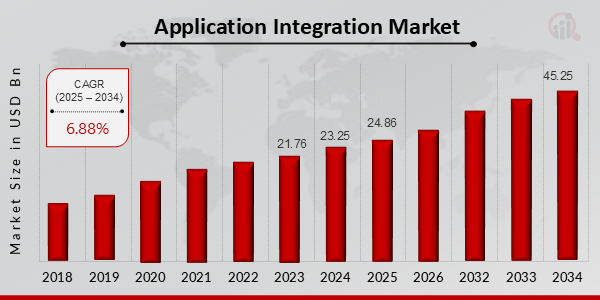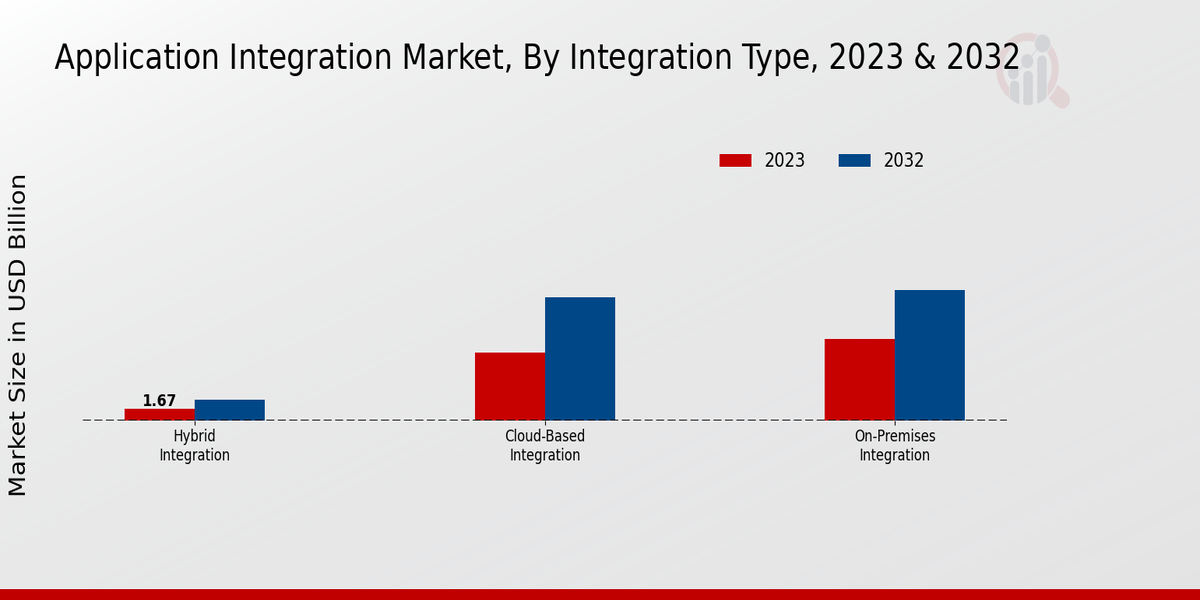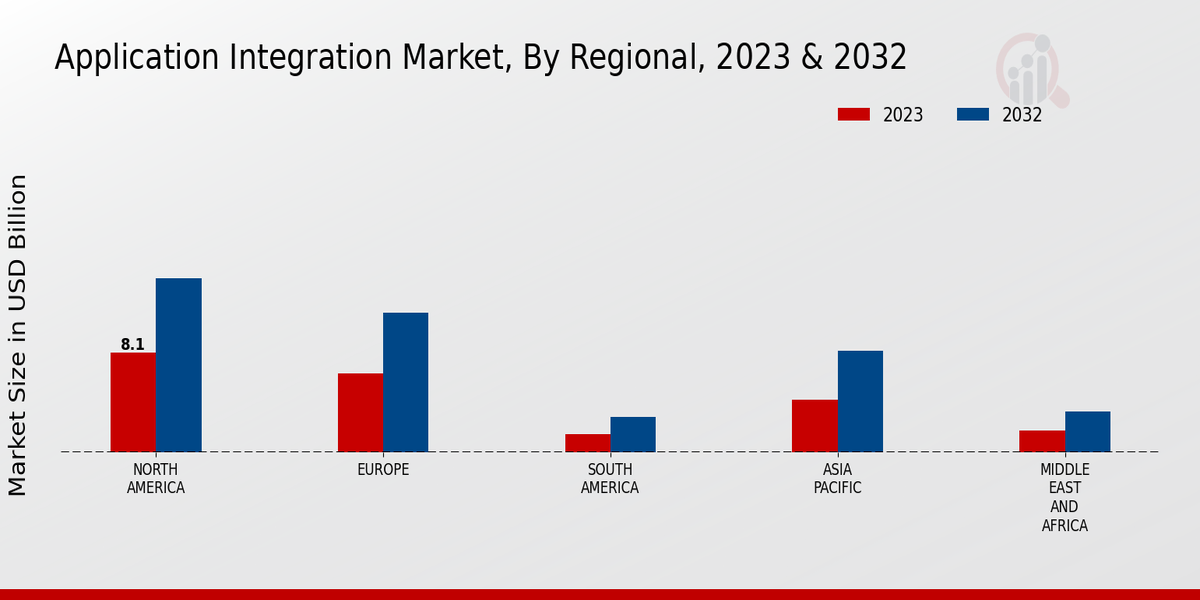Application Integration Market Overview
Application Integration Market is projected to grow from USD 24.86 Billion in 2025 to USD 45.25 Billion by 2034, exhibiting a compound annual growth rate (CAGR) of 6.88% during the forecast period (2025 - 2034). Additionally, the market size for Application Integration Market was valued at USD 23.25 billion in 2024.
Key Application Integration Market Trends Highlighted
The application integration market is witnessing a surge in demand due to factors such as the proliferation of cloud and mobile technologies, the need for seamless data exchange across disparate systems, and the rise of digital transformation initiatives. Key market drivers include the growing adoption of cloud-based applications, the increasing need for real-time data integration, and the demand for improved operational efficiency.
Businesses are exploring opportunities to integrate legacy systems with modern applications, foster collaboration among internal and external stakeholders, and leverage data from multiple sources for informed decision-making. Recent trends include the adoption of low-code/no-code integration platforms, the emergence of API-led connectivity, and the integration of artificial intelligence (AI) and machine learning (ML) for enhanced automation and data analysis.
Figure 1: Application Integration Market Size, 2025-2034 (USD Billion)

Source: Primary Research, Secondary Research, MRFR Database and Analyst Review
Application Integration Market Drivers
Increased Adoption of Cloud-Based Applications
The increasing adoption of cloud-based applications is a major driver of growth in the Application Integration Market Industry. Cloud-based applications offer a number of benefits over on-premises applications, including scalability, flexibility, and cost-effectiveness. As more and more businesses move their applications to the cloud, the demand for application integration solutions will continue to grow. Application integration solutions allow businesses to connect their cloud-based applications with their on-premises applications and data.
This enables businesses to create a unified view of their data and processes, which can lead to improved efficiency and decision-making. According to a recent study by Gartner, the worldwide public cloud services market is expected to grow from $494.7 billion in 2023 to $1.38 trillion by 2029, with a compound annual growth rate (CAGR) of 14.1%. This growth is being driven by the increasing adoption of cloud-based applications, as well as the growing popularity of cloud-based infrastructure services such as Infrastructure-as-a-Service (IaaS) and Platform-as-a-Service (PaaS). The growth of the cloud-based applications market is creating a number of opportunities for application integration vendors.
Vendors that can provide innovative and cost-effective solutions for integrating cloud-based applications with on-premises applications and data will be well-positioned to capitalize on this growth.
Growing Need for Data Integration
The growing need for data integration is another major driver of growth in the Application Integration Market Industry. Businesses are increasingly collecting data from a variety of sources, including internal systems, external data sources, and social media. This data can be used to improve customer segmentation, target marketing campaigns, and make better decisions. However, in order to use this data effectively, businesses need to be able to integrate it with their other data sources. Application integration solutions can help businesses to integrate data from a variety of sources.
This can enable businesses to create a unified view of their data, which can lead to improved data analysis and decision-making. According to a recent study by Forrester, the data integration market is expected to grow from $12.3 billion in 2023 to $22.8 billion by 2029, with a compound annual growth rate (CAGR) of 8.9%. This growth is being driven by the increasing need for data integration, as well as the growing popularity of cloud-based data integration solutions.
Increasing Adoption of Microservices
The increasing adoption of microservices is also driving growth in the Application Integration Market Industry. Microservices are a type of software architecture that decomposes an application into a set of small, independent services. This approach offers a number of benefits, including improved scalability, flexibility, and maintainability. As more and more businesses adopt microservices, the demand for application integration solutions will continue to grow.
Application integration solutions can help businesses to integrate microservices with each other, as well as with their other applications and data. According to a recent study by 451 Research, the microservices market is expected to grow from $4.5 billion in 2023 to $12.8 billion by 2029, with a compound annual growth rate (CAGR) of 14.3%. This growth is being driven by the increasing adoption of microservices, as well as the growing popularity of cloud-based microservices platforms.
Application Integration Market Segment Insights
Application Integration Market Integration Type Insights
The Application Integration Market is segmented based on Integration Type into On-premises integration, Cloud-based integration, and Hybrid integration. On-premises integration is a type of integration that is deployed and managed within an organization's own data center. This type of integration requires the organization to purchase and maintain the hardware and software necessary to support the integration. On-premises integration is often used for applications that are critical to the organization's operations and that need to be tightly controlled.
Cloud-based integration is a type of integration that is deployed and managed in the cloud. This type of integration does not require the organization to purchase and maintain the hardware and software necessary to support the integration. Cloud-based integration is often used for applications that are not critical to the organization's operations, and that can be easily replaced if necessary. Hybrid integration is a type of integration that combines on-premises integration and cloud-based integration. This type of integration allows organizations to take advantage of the benefits of both on-premises and cloud-based integration.
The growth of the market is attributed to the increasing adoption of cloud-based applications and the need for organizations to integrate their applications with each other. The On-premises integration segment is expected to account for the largest share of the market in 2023. However, the Cloud-based integration segment is expected to grow at a faster rate than the On-premises integration segment during the forecast period. This is due to the increasing adoption of cloud-based applications and the benefits that cloud-based integration offers, such as scalability, flexibility, and cost-effectiveness.
The Hybrid integration segment is expected to grow at a moderate rate during the forecast period. This is due to the fact that hybrid integration is a more complex and expensive solution than on-premises integration or cloud-based integration. However, hybrid integration offers the benefits of both on-premises integration and cloud-based integration, making it a viable option for organizations that need a flexible and scalable integration solution.

Source: Primary Research, Secondary Research, MRFR Database and Analyst Review
Application Integration Market Integration Method Insights
The Integration Method segment of the Application Integration Market is anticipated to grow significantly in the coming years. Middleware, API management, ESB (Enterprise Service Bus), data integration tools, and data virtualization are the key integration methods in this market. Middleware acts as a bridge between disparate applications, enabling them to communicate and exchange data seamlessly. API management platforms provide a centralized way to manage and secure APIs, making it easier for developers to integrate applications. ESB is a software architecture that simplifies the integration of heterogeneous systems and applications.
Data integration tools help businesses consolidate and integrate data from multiple sources into a unified view. The Integration Method segment is expected to account for a significant share of this growth due to the increasing need for businesses to integrate their applications and data to improve efficiency and gain a competitive edge.
Application Integration Market Industry Vertical Insights
The Banking, Financial Services, and Insurance (BFSI) vertical held the largest market share in 2023 and is projected to continue its dominance throughout the forecast period. The increasing need for secure and efficient data exchange, coupled with the growing adoption of digital banking and financial services, is driving the growth of the Application Integration Market in this vertical. The Healthcare vertical is also expected to witness significant growth as the demand for integrated healthcare systems and the need for seamless data sharing among various healthcare providers increase.
The Manufacturing vertical is another key segment where the Application Integration Market is expected to grow steadily due to the rising adoption of Industry 4.0 and the need for real-time data integration across manufacturing processes. The Retail vertical is also expected to contribute to the growth of the Application Integration Market, driven by the increasing adoption of e-commerce and the need for seamless integration between online and offline channels. The IT and Telecommunications vertical is expected to witness moderate growth as the demand for integrated communication and collaboration solutions continues to rise.
Application Integration Market Deployment Model Insights
The Application Integration Market is segmented into Single-tenant and Multi-tenant deployment models. Among these, the single-tenant deployment model accounted for a larger market share in 2023 and is projected to continue dominating the market throughout the forecast period. The dominance of the single-tenant deployment model can be attributed to its ability to provide dedicated resources and infrastructure to each customer, leading to higher levels of security, performance, and control. However, the multi-tenant deployment model is anticipated to experience significant growth during the forecast period due to its cost-effectiveness and scalability advantages.
By leveraging shared infrastructure and resources, multi-tenant deployment enables businesses to reduce IT expenses and optimize resource utilization. This cost efficiency is expected to drive the adoption of the multi-tenant model among small and medium-sized enterprises (SMEs) and enterprises seeking to reduce their IT budgets.
Application Integration Market Data Format Insights
The Application Integration Market is segmented into various data formats, including XML, EDI, SOAP, and REST. Among these, XML holds a significant market share due to its widespread adoption across different industries. In 2023, the XML segment was valued at USD 7.28 billion and is projected to reach USD 11.36 billion by 2032, exhibiting a CAGR of 5.8%. XML is a flexible and extensible data format that allows for the exchange of structured data between applications and systems. Its interoperability and ease of integration contribute to its popularity in various domains, including healthcare, finance, and manufacturing.
EDI (Electronic Data Interchange) is another widely used data format in the Application Integration Market. In 2023, the EDI segment was valued at USD 6.15 billion and is projected to reach USD 9.68 billion by 2032, growing at a CAGR of 6.1%. EDI is primarily utilized in industries like retail, transportation, and logistics, where the seamless exchange of business documents is crucial. SOAP (Simple Object Access Protocol) and REST (Representational State Transfer) are other notable data formats in the Application Integration Market. SOAP is an XML-based protocol that enables the exchange of structured data over HTTP, while REST is a lightweight architectural style that uses HTTP requests to access and manipulate resources.
The adoption of these data formats is driven by the increasing need for interoperability, data exchange, and integration between diverse applications and systems across various industries.
Application Integration Market Regional Insights
The regional segmentation of the Application Integration Market offers valuable insights into the market's geographical distribution and growth dynamics. North America holds a significant share of the market owing to the presence of several established technology companies and the early adoption of advanced IT solutions. Europe follows closely, driven by increasing digital transformation initiatives and government support for technology adoption. The APAC region is expected to witness substantial growth in the coming years due to rising demand for application integration solutions in emerging economies like India and China.
South America and MEA, while currently accounting for a smaller market share, present promising growth opportunities as businesses in these regions seek to enhance their operational efficiency and customer engagement. The Application Integration Market is expected to continue its growth trajectory, with the regional segments contributing to this expansion.

Source: Primary Research, Secondary Research, MRFR Database and Analyst Review
Application Integration Market Key Players And Competitive Insights
Major players in the Application Integration Market industry are constantly innovating and developing new solutions to meet the changing needs of businesses. Leading Application Integration Market players are investing heavily in research and development to stay ahead of the competition. The Application Integration Market is expected to grow significantly in the coming years, driven by the increasing adoption of cloud-based applications and the need for businesses to integrate their disparate systems. The competitive landscape of the Application Integration Market is expected to remain highly competitive, with new entrants and established players vying for market share.
One of the leading companies in the Application Integration Market is MuleSoft. MuleSoft provides a cloud-based integration platform that allows businesses to connect their applications and data. MuleSoft's platform is designed to be easy to use and scalable, making it a popular choice for businesses of all sizes. MuleSoft has a strong customer base and a wide range of partners, which gives it a competitive advantage in the market.
A key competitor to MuleSoft is Informatica. Informatica provides a comprehensive suite of data integration and management solutions. Informatica's solutions are designed to help businesses improve their data quality, performance, and security. Informatica has a strong track record of success and a large customer base. Informatica is a major player in the Application Integration Market and is expected to continue to be a strong competitor in the years to come.
Key Companies in the Application Integration Market Include:
-
Axway
-
Informatica
-
Oracle
-
Microsoft
-
UiPath
-
SAP
-
Infosys
-
IBM
-
Boomi
-
SnapLogic
-
DataDirect
-
Dell Boomi
-
WSO2
-
MuleSoft
-
Tibco
-
Software AG
Application Integration Market Industry Developments
The Application Integration Market is poised to experience significant growth in the coming years. The market is expected to reach USD 37.06 billion by 2032, exhibiting a CAGR of 6.88% from 2024 to 2032. This growth can be attributed to the increasing adoption of cloud-based applications, the need for seamless data integration, and the growing popularity of digital transformation initiatives.
Recent news developments in the market include the acquisition of MuleSoft by Salesforce, the launch of new integration platforms by Oracle and SAP, and the growing popularity of open-source integration tools. These developments are expected to further drive the growth of the market in the coming years.
Application Integration Market Segmentation Insights
-
Application Integration Market Integration Type Outlook
-
On-premises integration
-
Cloud-based integration
-
Hybrid integration
-
Application Integration Market Integration Method Outlook
-
Middleware
-
API management
-
ESB (Enterprise Service Bus)
-
Data integration tools
-
Data virtualization
-
Application Integration Market Industry Vertical Outlook
-
Banking, Financial Services, and Insurance (BFSI)
-
Healthcare
-
Manufacturing
-
Retail
-
IT and Telecommunications
-
Application Integration Market Deployment Model Outlook
-
Single-tenant
-
Multi-tenant
-
Application Integration Market Data Format Outlook
-
XML
- EDI
-
SOAP
-
REST
-
Application Integration Market Regional Outlook
-
North America
-
Europe
-
South America
-
Asia Pacific
-
Middle East and Africa
| Report Attribute/Metric |
Details |
|
Market Size 2024
|
23.25 (USD Billion)
|
|
Market Size 2025
|
24.86 (USD Billion)
|
|
Market Size 2034
|
45.25 (USD Billion)
|
|
Compound Annual Growth Rate (CAGR)
|
6.88% (2025 - 2034)
|
|
Report Coverage
|
Revenue Forecast, Competitive Landscape, Growth Factors, and Trends
|
|
Base Year
|
2024
|
|
Market Forecast Period
|
2025 - 2034
|
|
Historical Data
|
2019 - 2023
|
|
Market Forecast Units
|
USD Billion
|
| Key Companies Profiled |
Axway, Informatica, Oracle, Microsoft, UiPath, SAP, Infosys, IBM, Boomi, SnapLogic, DataDirect, Dell Boomi, WSO2, MuleSoft, Tibco, Software AG |
| Segments Covered |
Integration Type, Integration Method, Industry Vertical, Deployment Model, Data Format, Regional |
| Key Market Opportunities |
Cloud computing adoption API economy expansion big data integration increasing mobile device usage and IoT proliferation |
| Key Market Dynamics |
Cloud adoption API economy growth data integration surge |
| Countries Covered |
North America, Europe, APAC, South America, MEA |
Frequently Asked Questions (FAQ) :
The Application Integration Market is projected to reach USD 24.86 billion in 2025.
The Application Integration Market is projected to grow at a CAGR of 6.88% from 2025 to 2034.
North America is expected to hold the largest market share in the Application Integration Market in 2025.
The IT and telecom industry is expected to be the largest end-user of application integration solutions in 2025.
Some of the key competitors in the Application Integration Market include Oracle, IBM, Microsoft, SAP, and Informatica.
The key growth drivers of the Application Integration Market include the increasing adoption of cloud computing, the need for data integration, and the growing demand for real-time data access.
The key challenges facing the Application Integration Market include the complexity of integration projects, the lack of skilled professionals, and the security risks associated with data integration.
The key trends in the Application Integration Market include the adoption of API-led connectivity, the use of low-code/no-code integration tools, and the emergence of AI-powered integration solutions.
The Application Integration Market is projected to reach USD 37.06 billion by 2032.
The key opportunities for growth in the Application Integration Market include the growing demand for cloud-based integration solutions, the increasing adoption of IoT devices, and the need for data integration in the context of digital transformation initiatives.

















